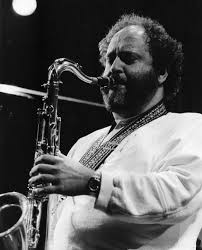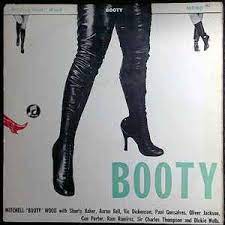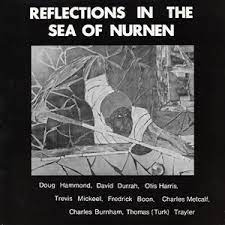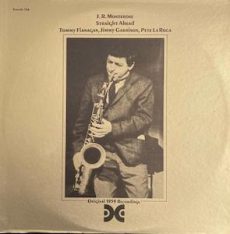
Three Wishes
The Baroness asked Joe Farrell what his three wishes would be and his response was:
- “Money! And if I had that, it would satisfy the second and third wish.”
More Posts: bandleader,history,instrumental,jazz,music,saxophone

Daily Dose Of Jazz…
Booty Wood was born Mitchell W. Wood on December 27, 1919 in Dayton, Ohio. He began playing professionally on trombone in the late 1930s. The following decade he worked with Tiny Bradshaw and Lionel Hampton before joining the Navy during World War II. While there he played in a band with Clark Terry, Willie Smith, and Gerald Wilson.
After his service ended he returned to play with Hampton, then worked with Arnett Cobb, Erskine Hawkins and Count Basie. After spending a few years outside music, Booty returned to play with Duke Ellington in 1959-60 and again in 1963. He returned once more early in the 1970s.
Wood once again played with the Count Basie Orchestra from 1979 into the middle of the following decade. Trombonist Booty Wood transitioned on June 10, 1987 in Dayton.
More Posts: history,instrumental,jazz,music,trombone

Daily Dose Of Jazz…
Doug Hammond was born December 26, 1942 in Tampa, Florida. His first major release was Reflections in the Sea of Nurnen on Tribe Records in 1975.
He has worked with musicians including Earl Hooker, Sonny Rollins, Charles Mingus, Sammy Price, Donald Byrd, Wolfgang Dauner, Ornette Coleman, Steve Coleman, Nina Simone, Betty Carter, Marion Williams, Paquito D’Rivera, Arnett Cobb, James Blood Ulmer and Arthur Blythe.
In 2010 Hammond wrote and conducted Acknowledgement Suite with Dwight Adams, Jean Toussaint, Roman Filiú, Howard Curtis, Wendell Harrison, Dick Griffin, Stéphane Payen, Kirk Lightsey and Arron James.
As an educator Doug was a professor at the Anton Bruckner Private University in Linz, Austria. His work has been filmed in a documentary Sparkle of Inspiration by the Austrian director Dieter Strauch.
Drummer, composer, poet, producer, and professor Doug Hammond, who plays in the free funk/avant-garde jazz genres, lives and continues to work in Linz.
More Posts: composer,drums,educator,history,instrumental,jazz,music

Daily Dose Of Jazz…
J.R. Monterose steps into the spotlight of this discussion with Straight Ahead (Xanadu Records 126). It was his second album as a leader and was released initially as The Message in 1960. J.R. was born Frank Anthony Peter Vincent Monterose Jr., and his initials come from Junior. He began playing the clarinet at age thirteen, then started the tenor sax two years later. Monterose was equally proficient on the soprano sax, but the tenor became his primary instrument. He’s collaborated with Kenny Burrell, Teddy Charles, Kenny Dorham, Jon Eardley, Charles Mingus, Buddy Rich, and George Wallington over his career. His bandmates on this date are three of the best in the business, Tommy Flanagan on piano, Jimmy Garrison on bass, and Pete La Roca on drums. My copy is the 1976 U.S. Mono reissue.
Straight Ahead, the first of five tunes composed by J.R. Monterose, opens the album with a brief introduction segueing into the quartet’s fleet melody. J.R. kicks off the solos with a brisk interpretation; next, Tommy builds a statement of pure excitement. J.R. and Pete share a swift exchange of notes, leading to the closing chorus and exit. Violet For Your Furs is a beautiful composition by Matt Dennis and Tom Adair from the forties. It begins with a brief dialogue between Monterose and Flanagan that blossoms into the ensemble’s elegant opening chorus. J.R. has the song’s only statement and brings out its warmth and lyricism in a display of intimate tenderness complemented by the rhythm section ahead of a soothing ending.
Chafic is the saxophonist’s tune for a French poodle he owned. The word’s definition in Arabic is merciful, and the pace moves upward for the foursome’s central theme. J.R. expresses his love and admiration for his pet in the opening statement. Tommy extends the pleasant feeling in the second interpretation, and Jimmy gets a bit of work leading to the climax. I Remember Clifford by Benny Golson, and Jon Hendricks closes the first side with a very touching rendition by the ensemble. The jazz standard is one of Golson’s most recorded tunes and a moving tribute to trumpeter Clifford Brown. A concise introduction by the leader opens the way for the foursome’s delicately gentle theme. Monterose again has the solo spotlight and crafts a charming interpretation into a serene finale.
Side Two is occupied by the final three tunes by J.R. Monterose, beginning with Green Street Scene, a blues that swings easily from the theme’s opening notes. The saxophonist goes to work first on an infectiously cheery solo. Tommy comes in next for an entertaining romp; then Jimmy takes a short stroll on the following reading. J.R. and Pete share a stimulating conversation before the close. You Know That is a swinger that the quartet brings vibrantly to life in the opening chorus. The saxophonist leads off with a compelling interpretation, then Flanagan gets into a swinging groove on the following statement. La Roca has a brief remark before Monterose returns for the closing theme reprise and a slow dissolve into nothingness.
Short Bridge is an exercise of pure joy, opening with a beautifully conceived melody and the opening statement by J.R. Tommy slides in next with one of his most mellow readings. The saxophonist returns with a memorable exclamation point ahead of the song’s conclusion. It’s unknown who produced the original album, but Don Schlitten produced the Xanadu reissue, and Paul Goodman remastered it. The album has an excellent soundstage through the treble, midrange, and low end. If you’re in the mood for an album that recaptures the spirit of Hard-Bop, I offer for your consideration Straight Ahead by J.R. Monterose. It’s a beautiful performance that’s highly recommended and worth the price of admission for a spot in any jazz library!
~ The Message (Jaro International JAM-5004/JAS-5004) – Source: Discogs.com ~ I Remember Clifford – Source: JazzStandards.com ~ Violet For Your Furs – Source: Wikipedia.org © 2022 by Edward Thomas Carter
More Posts: choice,classic,collectible,collector,history,instrumental,jazz,music,saxophone

Daily Dose Of Jazz…
Merritt Brunies was born on December 25, 1895 into a well-known musical family in New Orleans, Louisiana. Among its members were trombonist George Brunies and cornetist Albert Brunies.
Merritt led his own band, The Original New Orleans Jazz Band, from 1916 to 1918. Though this ensemble never recorded, it existed before both Jimmy Durante’s New Orleans Jazz Band and the Original Dixieland Jazz Band. Following this, he formed another group which played at Friar’s Inn in Chicago, Illinois directly after the stint by the New Orleans Rhythm Kings.
He played regularly in New Orleans in the 1930s, however, by 1946 he moved to Mississippi. There he played with his brothers in a Dixieland jazz band until his retirement. Trombonist and cornetist Merritt Brunies transitioned on February 5, 1973 in Biloxi, Mississippi.
More Posts: bandleader,cornet,history,instrumental,jazz,music,trombone




